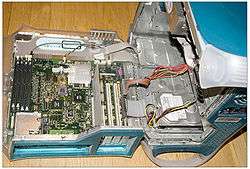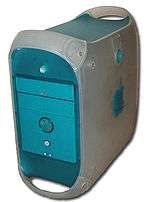Power Macintosh G3 (Blue & White)
|
The Blue & White Power Macintosh G3. | |
| Developer | Apple Computer Inc. |
|---|---|
| Type | Desktop (Minitower) |
| Release date | January 5, 1999 |
| Introductory price | $1,599 |
| Discontinued | August 31, 1999 |
| CPU |
PowerPC G3, 300 – 450 MHz |
| Predecessor | Power Macintosh G3 Beige |
| Successor | Power Mac G4 Graphite |

The Power Macintosh G3 series (commonly known as the "Blue and White G3", or sometimes either as the "B&W G3", "Yosemite G3" or "Smurf Tower" to distinguish it from the original Power Macintosh G3) is a short-lived series of personal computers designed, manufactured and sold by Apple Computer Inc. as part of their Power Macintosh line. It was introduced in January 1999, succeeding the original "beige" Power Macintosh G3, with which it shared the name and processor architecture but little else; it was discontinued in favor of the Power Mac G4 line in August 1999.
The Blue & White G3 used a modified version of the memory/PCI controller, the Motorola MPC106 (codenamed "Grackle"); it used the MPC106 v4. The I/O "Heathrow" had been replaced by "Paddington" (adding 100 Mbit Ethernet and power save features), the audio chip "Screamer" (on the beige G3's "Personality Card") had been replaced by "Burgundy", and other controllers for Firewire (Texas Instruments PCI-Lynx), for USB etc. were added.
Though still based on the PowerPC G3 architecture, the G3 B&W was a totally new design. The first new Power Mac model after the release of the iMac, it used a novel enclosure with the logic board on the folding "door", which swung down onto the desk for easy access (a design that was also used on all Power Mac G4 models except for the Cube), and borrowed the iMac's blue-and-white color scheme. It also introduced the New World ROM to the Power Macintosh line.
Hardware
The faster models (not the 300 MHz model) used the new copper-based PowerPC G3 CPUs made by IBM, which used about 25% of the power of the Motorola versions clock for clock. The B&W line ranged from 300 to 450 MHz. Despite its 100 MHz system bus and PC100 SDRAM, the 300 MHz B&W G3 performed worse than its 300 MHz Beige predecessor, because it had only 512 KB L2 cache, half of what the 300 MHz Beige had. The logic board had four PCI slots: three 64-bit 33 MHz slots, and one 32-bit 66 MHz slot dedicated for the graphics card, an ATI Rage 128 with 16 MB SGRAM. Four 100 MHz RAM slots accepted PC100 SDRAM modules, allowing the installation of up to 1 GB of RAM with the use of 256 MB DIMMs. The onboard ATA was upgraded to Ultra ATA/33 (in fact an extra UDMA-33 controller was added, see above), but SCSI was no longer present, having been replaced by two FireWire ports, a new standard (IEEE1394) running at 400 Mbit/s (50 MB/s) — faster in theory than even the ATA/33 (33 MB/s) hard drive controller. The serial ports were gone, too, having given way to two USB 1.1 ports (12 Mbit/s), as implemented already in the iMac. The ADB port remained, as did the option for an internal modem. Also gone was the internal floppy disk drive. 100BASE-TX Ethernet was now standard, and audio was moved back to the logic board. A Zip Drive remained an option, and some configurations included a DVD-ROM drive and a DVD-Video decoder daughtercard for the graphics card, allowing hardware-assisted DVD video playback.
The blue-and-white Power Macintosh G3 was the first Power Mac with the "New World" architecture which only contained a small (approximately 1 MB) boot ROM. When booting the Mac OS, the Mac OS Toolbox and any other ROM patches installed would be loaded into RAM (the former Beige G3 however was the first Mac with this ROM-in-RAM capability). Initially, many buyers chose to buy the older "Platinum" G3s instead, in order to maintain compatibility with existing peripherals.
Early blue and white G3s ("Revision 1" units) had IDE controller problems related to the ATA/33 hard drive controller that made it impossible to connect two hard drives and prevented the use of newer drives. Using newer ATA drives in those units resulted in data transmission errors if the drives were connected to the on-board ATA/33 controller, the severity of the problem varying according to the particular make and model of the drive. Workarounds include replacing motherboards and employing the use of SCSI, Ultra ATA or SATA PCI controller cards. Stable operation can be achieved if the drive can be limited to Multi-Word DMA Mode 2 (disabling UDMA), although this limits throughput to 16 MB/sec. Some hard drives support disabling UDMA in firmware through manufacturer-supplied utilities (generally DOS-based). Alternatively, the transfer mode can be limited to Multi-Word DMA Mode 2 through the use of third-party driver software such as FWB Hard Disk Toolkit.
The secondary ATA channel has also been reported to have issues with respect to flash upgrading certain DVD burners. Otherwise, it is generally held to be relatively stable.
Mac OS X attempts to avoid the UDMA issue by disabling UDMA on all affected G3 motherboards, but xlr8yourmac.com reported that reader Tim Seufert still found issues with single drives under Mac OS X. He reported that as of January 23, 2002, the fix would not be activated under Mac OS X when no slave drive was present.[1]
The "Revision 2" units fixed the hard drive controller problem with an improved (UDMA-33) IDE controller that supported the standard IDE master/slave two-drive arrangement. This controller worked flawlessly with any drive within the 28-bit LBA constraint. Most Rev. 2 units shipped with a hard disk bracket designed for two drives (in fact Rev. 1 can hold up to three drives side-by-side, while Rev. 2 can hold up to four drives in two stacks, each with two drives) and also included a slightly updated version of the Rage 128 graphics card. The easiest way to tell if the unit is a Rev.2 is by looking at the CMD chip located on the logic board. The CMD chip on Rev. 1 logic boards is PCI646U2 and on Rev. 2 logic boards is 646U2-402.[2]
Revision B 350, 400 and 450 MHz units use the same motherboard as the first "Yikes" version of Power Mac G4 systems at 350 and 400 MHz ("Sawtooth" AGP-based G4s used a different board) and processor cards for these models are interchangeable. Note that if a G3's firmware has been upgraded (a required update for installing Mac OS 9), it won't accept G4 CPUs until patched with a third-party replacement firmware.
Case
The blue and white G3's case design was widely praised at the time for being easy to open up and work on.[3] The entire right side of the case was a door that hinged down by pulling a recessed latch at the top. No components needed to be removed or unplugged to open the case, and in fact it could be done with the computer running. The logic board was positioned in the door, providing easy access to all components. The hard drive(s) were mounted in a bracket affixed with one screw on the floor of the case. This both made them easily accessible and improved their cooling by keeping them away from the heat-producing CPU and power supply. There was room for four internal hard drives and an internal fan was positioned at the side of the case to blow cooling air over them. Removable drives were in a more conventional position at the top of the case.
Operating System
The first Blue & White G3s shipped with Mac OS 8.5.1, while later revisions shipped with 8.6. The latest version of Mac OS that can be run on this model is Mac OS X 10.4 Tiger (current version: 10.4.11), as Mac OS X 10.5 Leopard discontinued support for G3 processors - although it is possible to run Leopard if the processor is upgraded to a G4 and several additional kexts are installed from Tiger or beta releases of Leopard.
Models
| Component | Power Macintosh G3 (Blue & White) | |
|---|---|---|
| Model | January 1999 | June 1999 (Rev. B) |
| Model #s | M6670LL/A (300 MHz), M6668LL/A or M6666LL/A (350 MHz), M6665LL/A (400 MHz) | M7556LL/A (350 MHz Rev. B), M7555LL/A or M7554LL/A (400 MHz Rev. B), M7553LL/A (450 MHz Rev. B) |
| Model identifier | PowerMac1,1 | |
| Processor | 300 MHz PowerPC G3 with 64 KB on-chip L1 cache and 512 KB on-chip L2 cache, or 350 MHz or 400 MHz PowerPC G3 with 64 KB on-chip L1 cache and 1 MB on-chip L2 cache | 350 MHz, 400 MHz, or 450 MHz PowerPC G3 with 1 MB on-chip L2 cache |
| Front side bus | 100 MHz | |
| Memory | 64 MB or 128 MB of unbuffered 100 MHz PC-100 SDRAM Upgradable to 1 GB | |
| Graphics Card | ATI Rage 128 GL with 16 MB of SDRAM graphics memory | |
| Hard drive | 6 GB, 9 GB, 12 GB, 20 GB, or 27 GB Ultra ATA hard disk drive Upgradable to 128 GB | |
| Optical Drive | 24x or 32x CD-ROM, 5x DVD-ROM drive | |
| Connectivity | 10/100 BASE-T Ethernet 56k modem (Optional) | |
| Expansion | 1x Zip Drive bay (Optional Zip Drive) 3x 64bit 33 MHz PCI slots 1x 66 MHz PCI slot (dedicated to video) | |
| Peripherals | 2x USB 1.1 2x Firewire 400 1x ADB Built-in mono speaker Audio input mini-jack Audio output mini-jack | |
| Original Operating System | Mac OS 8.5.1 | Mac OS 8.6 |
| Maximum Operating System | Mac OS X 10.4.11 "Tiger" and Mac OS 9.2.2 | |
| Dimensions | 27.8 lb (13 kg), 17" H × 8.9" W × 18.4" D (432×226×467 mm) | |
References
Sources
- Power Macintosh G3 (Blue & White):Technical Specifications on apple.com
- Developer Note Apple's internal description
- Power Macintosh G3 (Blue & White) on apple-history.com
- Power Macintosh G3 (Blue & White) on EveryMac.com
- Power Macintosh G3 (Blue & White) on Low End Mac
- Flash upgrading of Pioneer drives on secondary ATA channel issues (forum)
| Preceded by Power Macintosh G3 (minitower) |
Power Macintosh G3 (Blue & White) January 5, 1999 |
Succeeded by Power Mac G4 |
